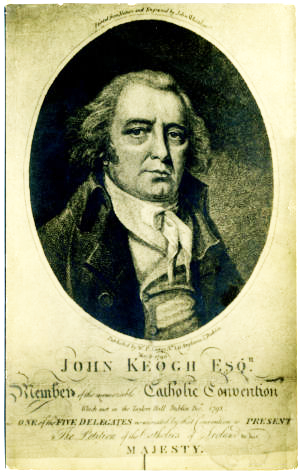John Keogh facts for kids
Quick facts for kids
John Keogh
|
|
|---|---|
 |
|
| Born | 1740 |
| Died | 1817 |
| Nationality | Irish |
| Political party | Society of United Irishmen |
| Movement | Catholic Committee, Catholic Convention |
John Keogh (1740 – 13 November 1817) was an Irish businessman and political activist. He was a main leader in the fight for Catholic Emancipation. This meant getting more rights for Catholics in Ireland. He also wanted to change the Irish Parliament. Keogh was very active in Dublin with the Catholic Committee. He was also involved, though with some doubts, in the Society of United Irishmen.
Contents
Early Life and Wealth
John Keogh was born in Dublin. His family was not well-known. He became very rich through smart business deals. He bought and sold land, made beer, and traded silk. Keogh owned land in Dublin and other parts of Ireland. By the 1790s, he had a large income.
Fighting for Catholic Rights
In the 1780s, Keogh started working for the rights of Roman Catholics. He joined the Catholic Committee in 1781. In 1784, he helped plan a way for groups in Ulster and Dublin to work together. Their goal was to get voting rights for Catholics. By 1790, Keogh was leading the Catholic Committee.
He was part of a group that tried to meet the Lord Lieutenant (the King's representative in Ireland). But they were not allowed to see him. So, they traveled to England to share their concerns. They wanted to end the "penal laws" which limited Catholic rights. They also wanted Catholics to be able to vote. They met with government ministers and received promises. However, another leader, Lord Kenmare, stopped their progress.
Working with Theobald Wolfe Tone
Theobald Wolfe Tone, a Protestant lawyer, became the Secretary of the Catholic Committee. He and Keogh became close friends. They often traveled around Ireland together. Tone even had a nickname for Keogh: 'Gog'.
The Catholic Convention
In December 1792, Keogh led a big meeting in Dublin called the Catholic Convention. People across Ireland were excited about the elections for this meeting. They hoped for big changes for Catholics. This also encouraged many Catholic farmers and shopkeepers to join a group called the Defenders. The King's representative, Lord Westmorland, asked London for more soldiers. The government in Dublin believed the United Irishmen were behind this, especially Keogh. Many delegates at the Convention were also members of the United Irishmen.
Some Catholic leaders were worried about the Convention. Keogh felt they were too used to old ways of thinking. He said they saw any move towards freedom as linked to violence in France. When the Convention started, Keogh made sure two important Catholic bishops sat near the chairman. But the final request from the Convention was given to the bishops as a done deal. Their approval was not really asked for.
Meeting the King
In January 1793, Keogh led a group, including Tone, to London. They carried a request asking for full rights for Catholics. The government wanted to make sure Catholics were loyal. This was because a war with France was starting. So, King George III met with Keogh's group.
In April, the government helped pass a Catholic Relief Act in the Dublin Parliament. This Act removed most of the old penal laws against Catholics. It allowed them to become lawyers and army officers. It also gave them the right to vote, similar to Protestants. However, Catholics still could not become members of Parliament itself. In return, Keogh promised that Catholics would not push for more separation from England. He also said their Committee would break up. Some people criticized Keogh for these promises.
In 1795, Keogh briefly brought the Committee back together. This was because the new Lord Lieutenant, Earl Fitzwilliam, supported full Catholic rights. But Fitzwilliam was recalled after only 100 days. Keogh led another group to London, but they were not taken seriously.
Later Influence
Keogh's power in the Catholic movement slowly decreased. New leaders started to emerge. However, he remained part of the Dublin committee of the United Irishmen until 1798. Keogh was often arrested and searched. But he was a moderate activist. He used his wealth to help Catholics without breaking the law too much. He was part of the non-violent side of the United Irishmen.
Days before the 1798 Rebellion began, Keogh printed a leaflet. He warned his followers in Dublin that the rebellion would not succeed. Some people wondered if Keogh might have secretly worked with the government. But others, like a government informer named Samuel Turner, said Keogh was unlikely to be a source of information for the government. Turner noted that Keogh did not even attend many important United Irishmen meetings.
Later Life and Legacy
John Keogh died in Dublin in 1817. He was buried in St. Kevin's Churchyard. You can still see his grave there today.

